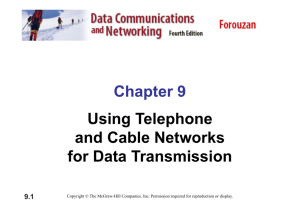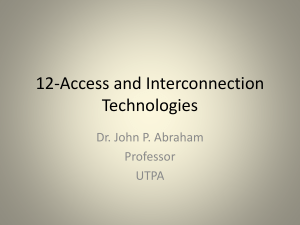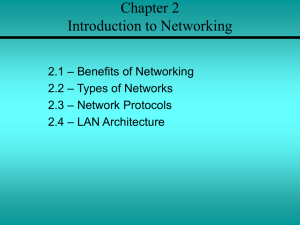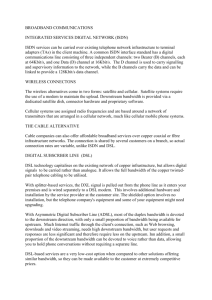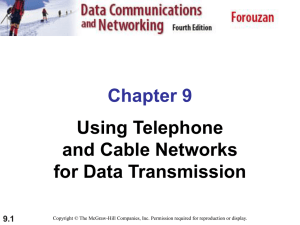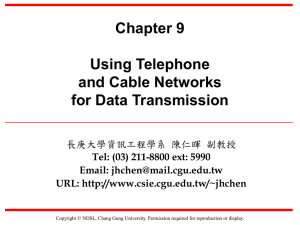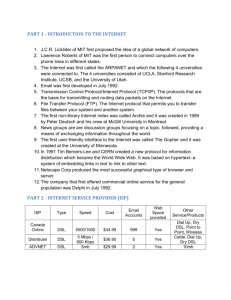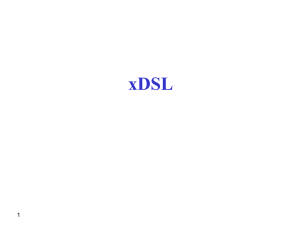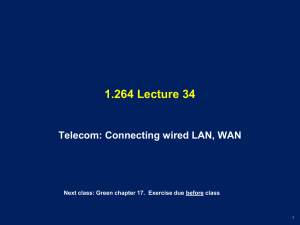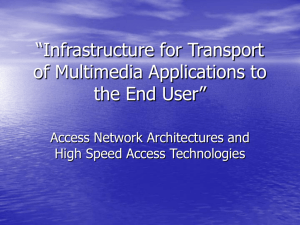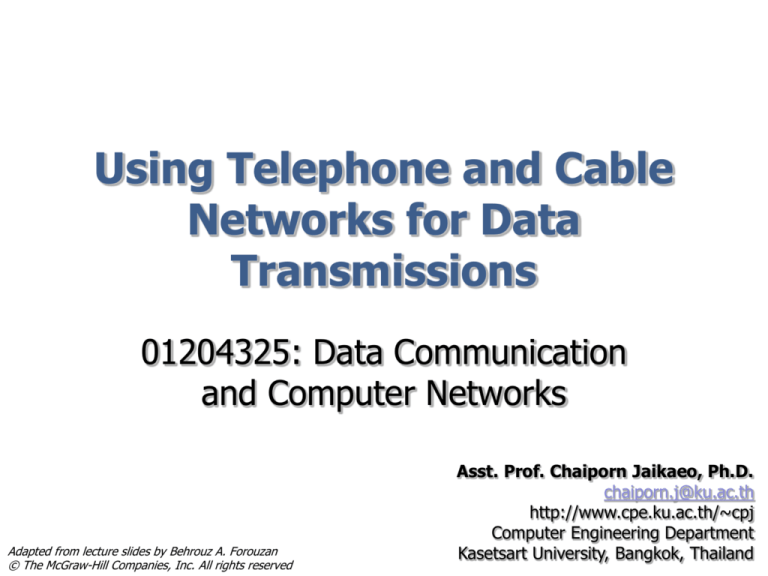
Using Telephone and Cable
Networks for Data
Transmissions
01204325: Data Communication
and Computer Networks
Adapted from lecture slides by Behrouz A. Forouzan
© The McGraw-Hill Companies, Inc. All rights reserved
Asst. Prof. Chaiporn Jaikaeo, Ph.D.
chaiporn.j@ku.ac.th
http://www.cpe.ku.ac.th/~cpj
Computer Engineering Department
Kasetsart University, Bangkok, Thailand
Outline
Telephone lines
Dial-up modems
Digital Subscriber Line (DSL)
Cable TV networks
2
Telephone Lines
Traditional telephone lines can carry
frequencies between 300 and 3300 Hz
Giving them a bandwidth of 3000 Hz
All this range is used for transmitting voice
A great deal of interference and distortion can
be accepted without loss of intelligibility
3
Telephone Line Bandwidth
4
Dial-Up Modems
Modem
stands for modulator/demodulator.
5
V.32 and V.32bis
6
56K Modems
7
Digital Subscriber Line (DSL)
Provides higher-speed access to the
Internet
Supports high-speed digital communication
over the existing local loops
The existing local loops can handle
bandwidths up to 1.1 MHz.
8
ADSL
ADSL – Asymmetric Digital Subscriber Line
Downstream bit rate > upstream bit rate
Designed for residential users
Unsuitable for businesses
ADSL operates on existing local loops
Local loops can handle up to 1.1 MHz of
bandwidth
The distance limit is ~18,000 feet
The system uses a data rate based on the
condition of the local loop line
9
Bandwidth Division in ADSL
10
Discrete Multi-Tone Modulation
Or DMT, based on OFDM (Orthogonal
Frequency-Division Multiplexing) technique
11
Bandwidth Division
4 kHz
Allocation and modulation of each channel
are determined adaptively
12
Bandwidth Division
Voice – Channel 0
Idle – Channels 1-5
Upstream – Channels 6-30
24 data channels, 1 control channel
1.44 Mbps (max) upstream bit rate
Actual bit rate: 64 Kbps to 1 Mbps
Downstream – Channels 31-255
224 data channels, 1 control channel
13.4 Mbps (max) downstream bit rate
Actual bit rate: 500 Kbps to 8 Mbps
13
ADSL Customer Residence
14
DSL Access Multiplexer
Or DSLAM
15
Other DSL Technologies
HDSL – High-bit-rate DSL
VDSL – Very-high-bit-rate DSL
SDSL – Symmetric DSL
ADSL2
ADSL2+
See also
Source: AWARE. ADSL2 and ADSL2+
The new ADSL standard.
http://en.wikipedia.org/wiki/Digital_subscriber_line
16
OFDM
Orthogonal Frequency-Division
Multiplexing
Widely used in wideband digital
communications
Digital TV
ADSL
Powerline communications
Wireless networks: Wi-Fi, WiMAX
4G mobile communications
17
OFDM Concept
Sub-carriers are orthogonal to each other
No cross-talk; guard bands not necessary
Source: http://connectedplanetonline.com
18
Orthogonality in OFDM
20 ms
Modulated @500 Hz
t
Modulated @550 Hz
t
Modulated @600 Hz
t
200
300
400
500
Frequency (Hz)
600
700
800
19
OFDM Implementation
Source: Wikipedia
20
Cable TV Networks
Started as a video service provider, then
moved to the business of Internet access
21
Hybrid Fiber-Coaxial Network
Or HFC
Bidirectional communication is achieved
22
Data Transfer over CATV
Standard: DOCSIS (Data Over Cable Service
Interface Specification)
Division of coaxial cable band by Cable TV
Theoretical downstream data rate is 30 Mbps
Theoretical upstream data rate is 12 Mbps
23
Cable Modem
24
Cable Modem Transmission System
Or CMTS
25
Fiber To The X
Optical broadband network architectures
Fiber-to-the-node
Fiber-to-the-curb
Fiber-to-the-building
Fiber-to-the-home
Source: Wikipedia
26

